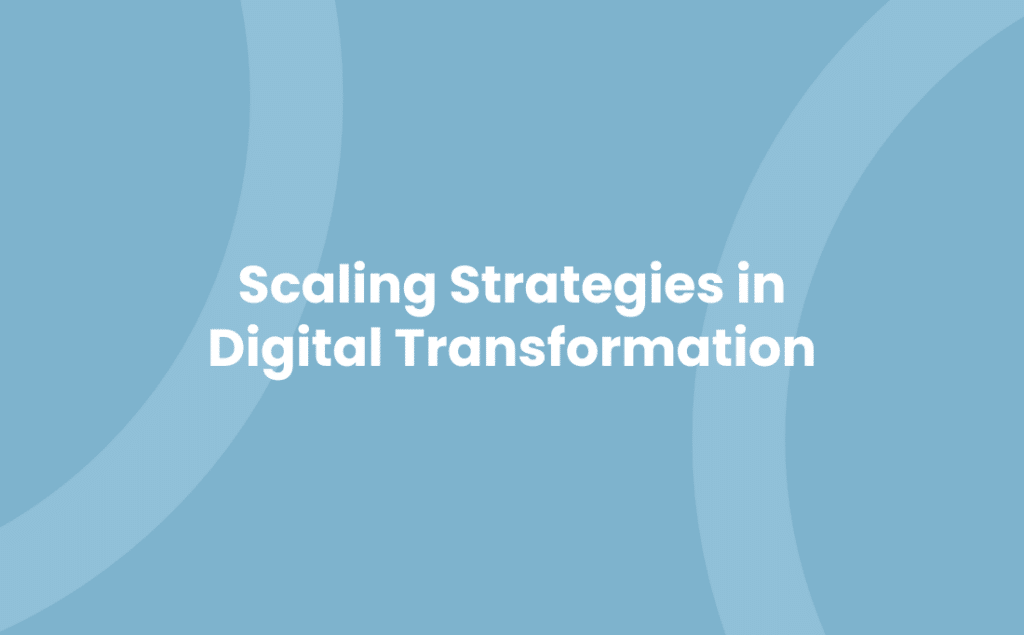Imagine a world where your business isn’t just surviving, but thriving, in the digital landscape. That’s the power of digital transformation scalability. It’s not just about adopting new technologies, but about scaling them effectively to boost your business growth.
In this fast-paced digital era, scalability is no longer optional, it’s a necessity. Your ability to grow and adapt in line with technological advancements could be the difference between success and failure. So, let’s dive into the world of digital transformation scalability and discover how it can catapult your business into the future.
Stay with us as we unravel the complexities of digital transformation scalability, and arm you with the knowledge to harness its potential. It’s time to step up your digital game, and we’re here to show you how.
Understanding Digital Transformation Scalability
Unlocking the full potential of your business in the digital landscape involves understanding digital transformation scalability. In essence, it’s the capacity of a digital solution to manage a growing amount of work, or its potential to expand to accommodate that growth. This forms the crux of thriving in the fast-paced, digitised world.
Digital scaling begins with the reimagining of business processes. This exercise breathes life into more streamlined, efficient workflows, increasing the efficacy of your digital solutions. By embracing scalable digital processes, you’re opening the doors to future growth and setting the stage for technological progress.
Investing in digital transformation scalability also means preparing your business for unforeseen changes. The digital arena can be unpredictable. By infusing scalability into your digital transformation efforts, you’re building resilience, able to pivot, and adjust with the ebbs and flows of digital advancements, weathering storms that may cause calamity for less prepared enterprises.
Moreover, flexibility is another key attribute of digital transformation scalability. With scalable digital solutions, your SME can effectively handle sudden influxes in data, workload, or system demand, without breaking a sweat. This flexibility is invaluable in maintaining consistent, high-quality service across every sector of your business.
Remember, digital transformation isn’t a one-time task. It’s a journey, one that shapes and directs your business towards digital maturity and sustainable growth. Understanding and embracing digital transformation scalability is a vital aspect of that trajectory‚ leading your organisation from merely surviving, to actively thriving, in the digital frontier.
Beyond all, embrace the learnings that come with every step on this transformative journey. Every challenge met, mistake made, and success achieved offers an opportunity to refine your digital scaling strategy, further honing your business’s competitive edge in the digital landscape. Irrespective of the pace, ensure your business is always moving forward, always learning, and always improving with digital transformation scalability. Only then will you tap into the true potential of the digital dawn.
Key Factors for Scalable Digital Transformation
Good grasp of “digital transformation scalability” is but a first step on the path to achieving its fruits. Businesses nosedive into the digital era, bearing in mind essential attributes to cultivate scalable transformations. Here are three key elements significant for fostering digital adaptability and growth:
- Proactive Strategy: Agile navigation through the digital landscape begins with a well-laid plan. Your strategy ought to incorporate future growth and anticipate varying digital requirements. Addressing impending workload, data, and system demands initially spares the burden of extensive changes down the line.
- Flexible Infrastructure: Scalability relies heavily on infrastructure. Your business’s technology backbone has to adjust to escalating demands aptly. Opting for scalable solutions, such as cloud-based systems, promotes versatility. These platforms scale with you, accommodating a gradually increasing digital load without compromising productivity.
- Regular Upgrades and Optimisations: The world of technology changes at breakneck speed. Regularly updating and optimising your digital systems is vital. This practice paves the way for constant improvement, promoting competitiveness and ensuring your systems stay updated with the latest digital trends.
Digital scaling transcends adding digital tools to a business model; it involves reengineering operations to support advancing technologies. Foresee potential shifts, choose flexible platforms, and maintain a practice of routine enhancements. These key factors significantly contribute to the effective scaling of digital transformation in your business. They foster resilience amidst digital fluctuations, setting your venture up for sustainable growth in the rapidly evolving digital space.
Achieving Scalability in Digital Transformation
Achieving scalability in digital transformation involves a few key elements. The establishment of proactive strategies and flexible infrastructures, coupled with regular system upgrades, immensely aids in adaptability. Strategising early and embracing evolving digital needs allows for lasting competitiveness in the accelerated digital landscape. Potent strategy, agility, and adaptability then become the bedrock of an enterprise’s resilience and sustainable growth.
Optimal strategy development delineates a clear vision of where business would like to be, informed by a comprehensive understanding of the organisation’s current position. Integrating flexibility into such a blueprint fosters adaptability to both anticipated and unanticipated changes.
Investing in a flexible and dynamic infrastructure promotes scalability. This infrastructure facilitates real-time modifications in response to external influences, unforeseen changes, or spontaneous growth spurts. For instance, Cloud-based services, known for their flexibility and scalability, permit easy modification of operations, storage, and business processes.
Routine system upgrades are the third pillar of digital transformation scalability. By consistently upgrading systems, businesses stay ahead of their competition and cope with the enhanced pace of digital advancements. In addition, routine system upgrades reduce the risks of obsolescence and security vulnerabilities.
In order to ensure continued relevance in the domain of digital transformation, businesses need to adopt a holistic approach that balances the triumvirate of proactive strategic development, flexible infrastructure, and regular system upgrades. This three-pronged approach will catalyse digital transformation scalability, laying the foundation for a resilient and growth-oriented digital future.
Remember, the digital landscape remains ever-responsive to advancements and changes; businesses must mirror this adaptability to remain competitive and relevant in the long term. In the journey of digital transformation, the most successful businesses are not just those that can predict the future, but also those that can efficiently respond and adapt to it. Act, adapt, and achieve, your formula for successful digital transformation scalability.
Case Studies on Successful Digital Transformation Scalability
To appreciate the real-life benefits of embracing digital transformation scalability, let’s examine a couple of illuminating case studies.
- Uber and Scalable Architecture: Uber, the app-driven taxi service, unveiled the incredible potential of digital scaling. The company launched its services in 2009 in San Francisco and within a few years, expanded operations globally to be present in over 60 countries. The core factor enabling this swift expansion was a scalable architecture, allowing Uber to accommodate variations in demand and growth across various regions.
- Netflix and Infrastructure Scalability: Another illustrative case is Netflix – the streaming giant, which started as a DVD rental service in the late 90s. Recognising the surge in online media consumption, Netflix pivoted to on-demand video streaming. A key player in this transformation was a scalable infrastructure – Amazon Web Services (AWS). Leveraging AWS’s flexibility allowed Netflix to balance loads and distribute content to millions of viewers simultaneously.
- Etsy and Continuous Delivery Approach: Etsy, an e-commerce platform, incorporates a continuous delivery approach, which is a quintessential aspect of digital transformation scalability. Leveraging a system of rapid and automated deployments, Etsy updates its application around 50 times a day. This approach helps the platform swiftly react to changes in market demand, keeping it competitive and flexible.
These case studies demonstrate that digital transformation scalability isn’t an abstract concept, but a tangible strategy. Businesses, irrespective of their size or industry, can leverage this approach to stake their claim in the digital landscape, adapt swiftly to unforeseen changes, and maintain a competitive edge. They highlight the pertinence of continuously updating systems and investing in flexible infrastructures to achieve scalability and sustained growth in the world of digital transformation.
Challenges in Digital Transformation Scalability
Embracing digital transformation scalability indeed brings exceptional benefits. However, it’s not always smooth sailing, several challenges might emerge along the way. Understanding these potential hurdles can prepare you for the journey, aiding in building resilience and ensuring continued business growth.
- Integration Difficulties: A critical challenge is integrating new digital systems with your existing technology stack. For instance, legacy platforms might struggle to handle the new processes, causing disruptions in your workflow.
- Security Concerns: With increasing digital dependence, cybersecurity becomes a substantial issue. You’ll find safeguarding sensitive data and managing potential threats isn’t a piece of cake when scaling digitally.
- Technological Disparities: As technology evolves relentlessly, disparities can easily creep in. It’s challenging to maintain consistency when tech advancements are ceaseless.
- Cultural Change: Digital transformation inevitably brings a cultural shift in your organisation. People, being creatures of habit, may resist these changes causing hindrances in the adoption process.
- Skills Gap: Upgrading digital capabilities requires skill sets that may not be present in your current team. This ‘skills gap’ is arguably one of the most daunting barriers to digital transformation scalability.
To exploit digital transformation scalability fully, acknowledging and addressing these challenges is crucial. With them in mind, you’ll be better prepared to navigate the path of scalability, ensure secure operations, and ultimately achieve sustained digital growth.
Strategies for Overcoming Scalability Challenges
Easing the path of digital transformation scalability is achievable, provided you factor in certain critical strategies. Digital scaling, after all, broadens horizons and equips your business to manage fluctuations and surges with agility and poise. These critical practices sync with the vision of staying at the crest of the digital wave:
- Leverage Automation:
Employ automation to replace manual and repetitive tasks. Such a shift in your operational model not only frees up your workforce for strategic chores but also reduces errors, bolstering the scalability of your digital transformation efforts. - Invest in Agile Infrastructure:
Your digital infrastructure is the linchpin for smooth sailing in the digital scaling journey. An agile, scalable infrastructure flexible to variations is a necessary pivot point. For instance, cloud adoption serves to negate the physical limitations of your enterprise, thus fostering lasting digital expansion. - Cement Data Governance:
Streamlined data governance offers you a firm handle on your data assets. Clear-cut policies and protocols in place help you manage data efficiently: a pivotal necessity in a rapidly digitising business environment. - Cybersecurity Preparedness:
Too often, stakeholders in the haste of scaling overlook cybersecurity. This negligence leaves businesses more vulnerable to security breaches and cyber threats. Prioritise solid cybersecurity measures, and incorporate them into your scalability blueprint right from the get-go. - Cultivate a Tech-centered Culture:
Promising digital transformation scalability extends beyond technological changes to encompass a shift in culture. Cultivate a tech-savvy team fine-tuned to digital changes, equipped with the skillset to harness them fruitfully.
Learn from seasoned enterprises such as Uber and Netflix who have aced digital scaling. Embed resilience, and the willingness to experiment in your culture. This dynamism sees you through challenging times, helping your enterprise strike that coveted balance between stability and agility.
Conclusion
So, you’ve seen how digital transformation scalability plays a pivotal role in business success. It’s evident from industry giants like Uber and Netflix that scalability is not just an option; it’s a necessity for global expansion and competitiveness. However, it’s not a walk in the park. You’ll face integration complexities, security issues, technological gaps, cultural shifts, and skills shortages. But don’t let these challenges deter you. Instead, let them guide you in navigating the scalability journey. With strategies like automation, agile infrastructure, robust data governance, cybersecurity preparedness, and a tech-centric culture, you’re well on your way to overcoming these hurdles. Remember, resilience, a culture of experimentation, and finding the balance between stability and agility are the keys to successful digital scaling. So, gear up for this exciting journey and embrace the transformation that lies ahead.


